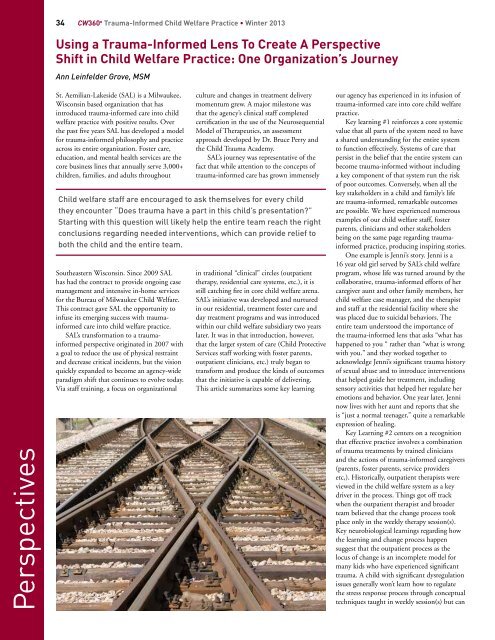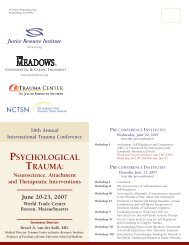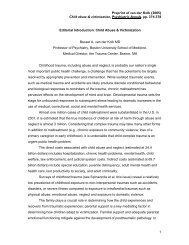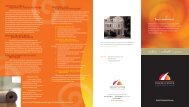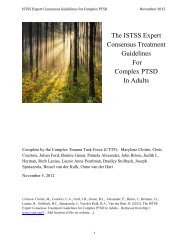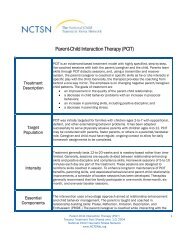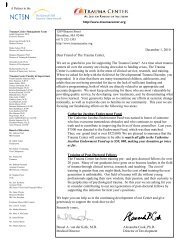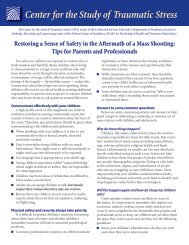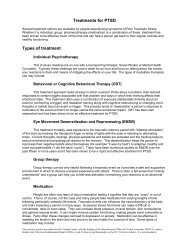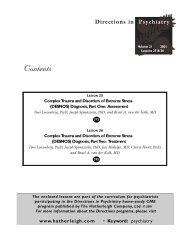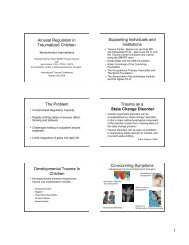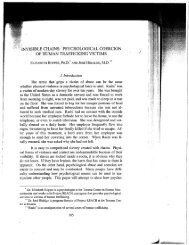in Child Welfare - The Trauma Center
in Child Welfare - The Trauma Center
in Child Welfare - The Trauma Center
You also want an ePaper? Increase the reach of your titles
YUMPU automatically turns print PDFs into web optimized ePapers that Google loves.
34 CW360 o <strong>Trauma</strong>-Informed <strong>Child</strong> <strong>Welfare</strong> Practice • W<strong>in</strong>ter 2013Us<strong>in</strong>g a <strong>Trauma</strong>-Informed Lens To Create A PerspectiveShift <strong>in</strong> <strong>Child</strong> <strong>Welfare</strong> Practice: One Organization’s JourneyAnn Le<strong>in</strong>felder Grove, MSMPerspectivesSt. Aemilian-Lakeside (SAL) is a Milwaukee,Wiscons<strong>in</strong> based organization that has<strong>in</strong>troduced trauma-<strong>in</strong>formed care <strong>in</strong>to childwelfare practice with positive results. Overthe past five years SAL has developed a modelfor trauma-<strong>in</strong>formed philosophy and practiceacross its entire organization. Foster care,education, and mental health services are thecore bus<strong>in</strong>ess l<strong>in</strong>es that annually serve 3,000+children, families, and adults throughoutSoutheastern Wiscons<strong>in</strong>. S<strong>in</strong>ce 2009 SALhas had the contract to provide ongo<strong>in</strong>g casemanagement and <strong>in</strong>tensive <strong>in</strong>-home servicesfor the Bureau of Milwaukee <strong>Child</strong> <strong>Welfare</strong>.This contract gave SAL the opportunity to<strong>in</strong>fuse its emerg<strong>in</strong>g success with trauma<strong>in</strong>formedcare <strong>in</strong>to child welfare practice.SAL’s transformation to a trauma<strong>in</strong>formedperspective orig<strong>in</strong>ated <strong>in</strong> 2007 witha goal to reduce the use of physical restra<strong>in</strong>tand decrease critical <strong>in</strong>cidents, but the visionquickly expanded to become an agency-wideparadigm shift that cont<strong>in</strong>ues to evolve today.Via staff tra<strong>in</strong><strong>in</strong>g, a focus on organizationalculture and changes <strong>in</strong> treatment deliverymomentum grew. A major milestone wasthat the agency’s cl<strong>in</strong>ical staff completedcertification <strong>in</strong> the use of the NeurosequentialModel of <strong>The</strong>rapeutics, an assessmentapproach developed by Dr. Bruce Perry andthe <strong>Child</strong> <strong>Trauma</strong> Academy.SAL’s journey was representative of thefact that while attention to the concepts oftrauma-<strong>in</strong>formed care has grown immensely<strong>Child</strong> welfare staff are encouraged to ask themselves for every childthey encounter “Does trauma have a part <strong>in</strong> this child’s presentation?”Start<strong>in</strong>g with this question will likely help the entire team reach the rightconclusions regard<strong>in</strong>g needed <strong>in</strong>terventions, which can provide relief toboth the child and the entire team.<strong>in</strong> traditional “cl<strong>in</strong>ical” circles (outpatienttherapy, residential care systems, etc.), it isstill catch<strong>in</strong>g fire <strong>in</strong> core child welfare arena.SAL’s <strong>in</strong>itiative was developed and nurtured<strong>in</strong> our residential, treatment foster care andday treatment programs and was <strong>in</strong>troducedwith<strong>in</strong> our child welfare subsidiary two yearslater. It was <strong>in</strong> that <strong>in</strong>troduction, however,that the larger system of care (<strong>Child</strong> ProtectiveServices staff work<strong>in</strong>g with foster parents,outpatient cl<strong>in</strong>icians, etc.) truly began totransform and produce the k<strong>in</strong>ds of outcomesthat the <strong>in</strong>itiative is capable of deliver<strong>in</strong>g.This article summarizes some key learn<strong>in</strong>gour agency has experienced <strong>in</strong> its <strong>in</strong>fusion oftrauma-<strong>in</strong>formed care <strong>in</strong>to core child welfarepractice.Key learn<strong>in</strong>g #1 re<strong>in</strong>forces a core systemicvalue that all parts of the system need to havea shared understand<strong>in</strong>g for the entire systemto function effectively. Systems of care thatpersist <strong>in</strong> the belief that the entire system canbecome trauma-<strong>in</strong>formed without <strong>in</strong>clud<strong>in</strong>ga key component of that system run the riskof poor outcomes. Conversely, when all thekey stakeholders <strong>in</strong> a child and family’s lifeare trauma-<strong>in</strong>formed, remarkable outcomesare possible. We have experienced numerousexamples of our child welfare staff, fosterparents, cl<strong>in</strong>icians and other stakeholdersbe<strong>in</strong>g on the same page regard<strong>in</strong>g trauma<strong>in</strong>formedpractice, produc<strong>in</strong>g <strong>in</strong>spir<strong>in</strong>g stories.One example is Jenni’s story. Jenni is a16 year old girl served by SAL’s child welfareprogram, whose life was turned around by thecollaborative, trauma-<strong>in</strong>formed efforts of hercaregiver aunt and other family members, herchild welfare case manager, and the therapistand staff at the residential facility where shewas placed due to suicidal behaviors. <strong>The</strong>entire team understood the importance ofthe trauma-<strong>in</strong>formed lens that asks “what hashappened to you “ rather than “what is wrongwith you.” and they worked together toacknowledge Jenni’s significant trauma historyof sexual abuse and to <strong>in</strong>troduce <strong>in</strong>terventionsthat helped guide her treatment, <strong>in</strong>clud<strong>in</strong>gsensory activities that helped her regulate heremotions and behavior. One year later, Jenn<strong>in</strong>ow lives with her aunt and reports that sheis “just a normal teenager,” quite a remarkableexpression of heal<strong>in</strong>g.Key Learn<strong>in</strong>g #2 centers on a recognitionthat effective practice <strong>in</strong>volves a comb<strong>in</strong>ationof trauma treatments by tra<strong>in</strong>ed cl<strong>in</strong>iciansand the actions of trauma-<strong>in</strong>formed caregivers(parents, foster parents, service providersetc,). Historically, outpatient therapists wereviewed <strong>in</strong> the child welfare system as a keydriver <strong>in</strong> the process. Th<strong>in</strong>gs got off trackwhen the outpatient therapist and broaderteam believed that the change process tookplace only <strong>in</strong> the weekly therapy session(s).Key neurobiological learn<strong>in</strong>gs regard<strong>in</strong>g howthe learn<strong>in</strong>g and change process happensuggest that the outpatient process as thelocus of change is an <strong>in</strong>complete model formany kids who have experienced significanttrauma. A child with significant dysregulationissues generally won’t learn how to regulatethe stress response process through conceptualtechniques taught <strong>in</strong> weekly session(s) but can


